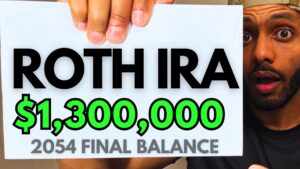Listen Now
Listen on iTunes.
Listen on Google.
Listen on Stitcher.
Transcript
Last week we started a series on retirement accounts and touched on the 401(k) plan. Hopefully you’ve done some work with your employer to go over your 401k plan and optimize the investments and amount your contribution as best as you can. For those who have 403b’s the same general rules apply and at the end of the day you’ll want to check with your employer on the specifics.
For this episode we’ll be discussing two different kinds of retirement plans and I thought it would be best to do one episode and compare them.
I’m talking about the Traditional IRA and the Roth IRA. We all know IRA to stand for Individual Retirement Account, but IRS actually defines IRA as Individual Retirement Arrangement. Makes sense, but nowadays you’ll hear the A in IRA referred to as Account more than Arrangement. Thought that was something interesting.
Let’s get started:
Remember last week we learned that a traditional 401k will be available through an employer and 403b plans operate similarly except these are offered by nonprofit companies, religious groups, school districts, and governmental organizations. The company or organization you work for has to offer this plan for you. And you’re allowed to save up to $18,500 in these accounts. Also, I didn’t mention last week, but if you’re age 50 or older the government allows you to save an additional $6,000 in a 401k or 403b as a “catch-up” contribution, so instead of $18,500, that’s $24,500. And those limits don’t count any company match being offered.
But what if you wanted to save even more or didn’t like the 401k investment choices? Well this is where you have some options.
How Are Taxes Treated?
You can have a traditional IRA and/or a Roth IRA. Probably the most significant difference between the two is how taxes are treated.
In a traditional IRA you defer or delay paying taxes on contributions to a later time, like retirement where you’ll hopefully be living in a lower tax bracket. When you start withdrawing money from your Traditional IRA bucket that’s when you pay taxes on the what you contributed and any gains that your contributions made.
With a Roth IRA you’re contributing money you’ve already paid taxes on. When it comes time to make withdrawals, you don’t pay any taxes on what you contributed and you don’t pay any taxes on any of the growth. So the money grow tax-free! There’s people out there who believe in the future the government will apply some sort of back end tax on Roth IRAs, but for now or anytime soon it’s not a concern.
So for those who are in a low tax bracket right now the Roth IRA makes sense. And for those in a higher tax bracket a traditional IRA makes sense, because you’re able to lower the amount of taxes you pay and keep more of your money for yourself.
How Much Can I Contribute?
For both Traditional IRAs and Roth IRAs you’re allowed to contribute up to $5,500/year or $6,500/year if you’re 50 or older. There’s that “catch-up” contribution again.
Also, the amount you contribute can’t exceed how much you made that year. So let’s say for whatever reason you made $4,000 in a year and you get a $5,000 gift from grandpa and grandma…no matter what you can only contribute $4,000. What you contribute can’t be greater than your earned income.
Who Qualifies for a Traditional IRA? Roth IRA?
Now there are certain requirements that must be met in order to have and contribute to a Roth IRA. Unfortunately not just anyone can open a Roth IRA and contribute all the money they want in the world. But as we’ll discover everyone can actually have a Roth IRA no matter your income and we’ll learn more about how to do that later.
If you’re thinking about opening a Roth IRA, there are two considerations you’ll want to note. First, your tax filing status. For this episode we’ll just focus on two: single and married filing jointly. For those who file single you can open and contribute to a Roth IRA if your 2018 modified adjusted gross income is less than $135,000 and those whose status is married filing jointly your income is less than $199,000.
There are phase out limits, meaning the amount you can contribute to a Roth IRA decreases once you reach a certain income level. For single filers that phase out threshold is $120,000. For married filing jointly, the phase out begins at $189,000. So this is something you want to check with your tax professional to understand how much you can contribute if you fall in this category.
For traditional IRAs the rule is pretty simple: Basically everyone with earned income can contribute to a traditional IRA, however your income and participation in an employer plan like a 401k will affect your tax deductibility.
Spouses who don’t work can also have a Roth IRA or Traditional IRA. It’s known as a spousal IRA. is an exception for individuals with spouses who are employed and meet certain requirements. The employed spouse is allowed to make an IRA contribution on behalf of a non-working spouse or a spouse who has little income. These contributions are referred to as “spousal IRA contributions.” Here we review the requirements for making spousal IRA contributions.
To make an IRA contribution for your spouse, you have to meet the following requirements: You must be married, you have to file a joint income-tax return, and your earned income must be at least the amount you contribute to your IRAs. So just because the spouse is not earning income, doesn’t mean he or she can’t have a tax-advantaged retirement account.
What About Withdrawing the Money?
Contributions in a Roth IRA can be withdrawn at any time, tax-free and penalty free. To withdraw earnings tax-free you’ll have to wait five years and be at least 59½. Withdrawals are not required during your lifetime. This makes for an interesting alternative savings account, possibly an emergency fund. And you can leave the money to any beneficiary to inherit and not worry about taxes.
When it comes to a traditional IRA, withdrawals are penalty free beginning at age 59½. And you will have to take distributions at age 70½ ; any money left behind in a Traditional IRA, the beneficiaries will pay taxes on inherited IRAs.
So whichever IRA you choose to have, maybe both, you’ll want to consider the back end when you start taking withdrawals and whether you want to worry about paying taxes now or later.
Investment Selections?
You have a wide array of investment choices available to you in IRAs from CDs to bonds to stocks and mutual funds. It’s all there. You all already know I’m an index fund fan. A big factor in maximising the profitability of your retirement accounts is how much you’re paying in fees. Keep fees low. Do your homework and compare your investment fees to my favorite funds out there like Vanguard, Charles Schwab or Fidelity’s US Total Market Fund. Compared to high cost investments you’re paying pennies in fees for investments that most times perform just as good if not better than what’s out there. Remember, this is about long-term wealth building.
Back Door Roth IRA?
So I mentioned everyone can have a Roth IRA. You’re probably saying, “Wait you stated there were income limits for opening and contributing to a Roth IRA.” While this is true, there is a strategy out there for high income earners to have a Roth IRA. It’s called the Back Door Roth IRA. There’s a lot of information out there about the Back Door Roth IRA and something called the mega-backdoor Roth IRA and we’ll dig deeper into these two in the next episode next week. For, now just know you do have an opportunity to have your money grow tax free in a Roth IRA, regardless of income. And this isn’t some big secret, it’s really an opportunity that our tax authors and government continue to allow year after year.
Conclusion and Key Differences?
When it comes down to it I like having a Roth IRA over the Traditional IRA. There are strategies to optimize the traditional IRA and ultimately paying little tax by converting the money to a Roth IRA over time which is going to be a topic I cover in the future. Either way you can’t go wrong having one or the other if you’re just getting started. The easiest way to decide whether to choose a Roth IRA or Traditional IRA is by thinking about when you want to pay taxes on your contributions and growth. If you want to pay now and get it over with, then go with the Roth IRA. If you want the deduction today and worry about paying taxes later then go with the Traditional IRA.



